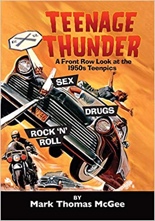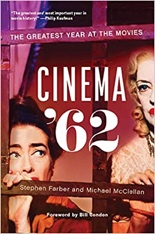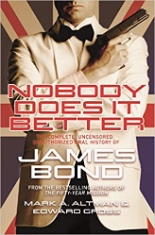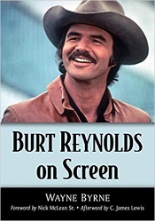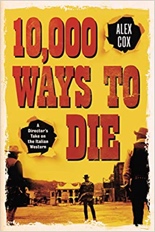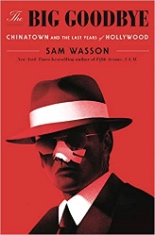
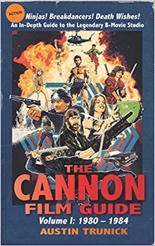 Look, here is everything I dislike about Austin Trunick’s The Cannon Film Guide: Volume I, 1980-1984:
Look, here is everything I dislike about Austin Trunick’s The Cannon Film Guide: Volume I, 1980-1984:
• Volume II is not yet available.
• Volume III is not yet available.
Otherwise, this book is B-movie gold.
Anyone who has seen Mark Hartley’s amazing 2014 documentary, Electric Boogaloo: The Wild, Untold Story of Cannon Films, knows that when it comes to The Cannon Group — and Israeli cousins/co-owners Menahem Golan and Yoran Globus — no shortage of great stories exists.
Whereas Hartley was limited to a manageable running time, print carries no such burden, and Trunick takes full advantage of that freedom — as if the behind-the-scenes book being broken into a trilogy weren’t already a dead giveaway. For example, Hartley’s doc recounted Golan and Globus’ decision to flip the order of the first two films in Chuck Norris’ Missing in Action franchise, but Trunick shares the full, more complicated details. While he may not have A-list access in terms of interviewees, he has the luxury of getting to plumb the depths of the deets … and strikes the mother lode.
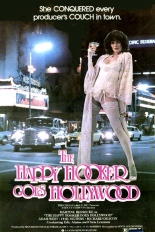 Starting with 1980’s The Happy Hooker Goes Hollywood, Golan and Globus’ first release after purchasing Cannon, Trunick devotes a chapter to each movie they theatrically released in the United States. Yes, that means The Last American Virgin and Ninja III: The Domination, but it also means such forgotten oddities as Seed of Innocence and Over the Brooklyn Bridge — the latter of which was advertised and opened with the wrong iconic bridge, the Manhattan, which Golan brushed off thusly: “Eh, a bridge is a bridge.”
Starting with 1980’s The Happy Hooker Goes Hollywood, Golan and Globus’ first release after purchasing Cannon, Trunick devotes a chapter to each movie they theatrically released in the United States. Yes, that means The Last American Virgin and Ninja III: The Domination, but it also means such forgotten oddities as Seed of Innocence and Over the Brooklyn Bridge — the latter of which was advertised and opened with the wrong iconic bridge, the Manhattan, which Golan brushed off thusly: “Eh, a bridge is a bridge.”
While the standout chapters are — no shock — about the making of Cannon’s bread-and-butter classics (those referenced on the book’s cover tagline: “Ninjas! Breakdancers! Death Wishes!”), I confess it may be even more fun to read about Cannon’s legendary failures and the misbehavior that contributed to their downfall. For example, That Championship Season’s legitimate awards-season bid goes up in flames at the premiere when notorious alcoholic Robert Mitchum decides to hurl a basketball into a woman’s face. Then there the diva demands of Brooke Shields’ mother, Teri, “working” as a first-time producer on the flop adventure Sahara with bold displays of ego strokes — and swaths! — bested only by John and Bo Derek on the ill-fated sex romp Bolero. (And that’s really saying something when we also have Faye Dunaway at play, as The Wicked Lady.)
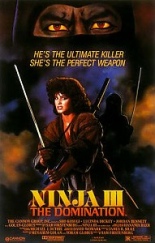 The misbehavior extends to Golan and Globus, of course, particularly in getting a Hercules sequel out of Lou Ferrigno under the guise of reshoots, so they wouldn’t have to pay him!
The misbehavior extends to Golan and Globus, of course, particularly in getting a Hercules sequel out of Lou Ferrigno under the guise of reshoots, so they wouldn’t have to pay him!
The book is well-researched, with only a few factual nits to pick, from incorrectly identifying the boxing drama Body and Soul as the first time Leon Isaac Kennedy and Jayne Kennedy shared the big screen (don’t forget Death Force!) and the campus comedy Making the Grade as the movie that gave us Andrew “Dice” Clay (it was Wacko), to denying poor Robert MacNaughton his due by giving credit for his role as the big brother in E.T. to Sean Frye. (Elsewhere, I’ll let the misspelling of Jon Voight’s name slide since the man has become a lunatic.)
When available, Q&As with key players supplement the film discussions. Again, Trunick may not have landed interviews with above-the-title talent, but everyone he did get adds considerable insight and value, including The Apple’s Catherine Mary Stewart, frequent helmer Sam Firstenberg (Revenge of the Ninja) and uncredited Exterminator 2 director William Sachs.
Published by BearManor Media and numbering more than 525 pages, this first Cannon Film Guide is as thorough as you’d hope it would be. Initially, I thought I might skip reading about the movies I disliked or had no interest in seeing, but that proved futile, because Trunick’s work is excellently entertaining. Less than 48 hours later, I had devoured every word. Given that Volume II promises to spotlight Cannon’s golden age, I cannot wait for more. —Rod Lott
Get it at Amazon or BearManor Media.

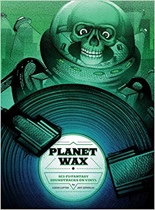
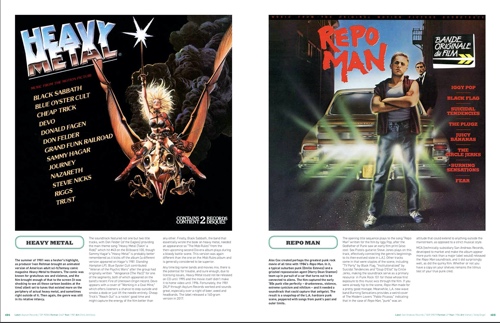
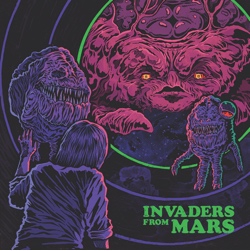 Hell, speaking of, there’s even a spread on Star Wars
Hell, speaking of, there’s even a spread on Star Wars 